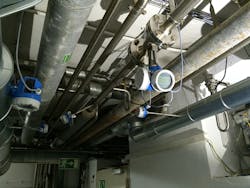Vortex Flowmeter Helps Cheese Maker Reduce Steam Bill by 10% Annually
2015 Innovation Award Winner:
Proline Prowirl 200 Vortex Flowmeter — By Endress+Hauser
The processes within the dairy industry require a lot of energy. These energy-intensive processes can include demineralized whey powder, milk sugar, whole milk, milk powder, sweet whey powder, customized blends, ice cream and cheese. The production of these derivatives requires energy from steam. In food applications in general, steam can be used for process heating, evaporation, sterilization, and to elicit process reactions.
A common challenge is how steam is distributed throughout a plant. The distances between the point of generation and plant use points can be over 3,000 feet apart. Steam quality at these use points can cause end-users to experience inaccurate cost allocations and varying energy efficiencies. Qualitative energy measurement is the only way to reliably improve efficiency and cost assignment in these cases.
Recently, a dairy was looking at a way to improve its steam measurement and cost allocation for their individual users. After evaluation, the dairy determined it was operating at 85 percent steam quality or dryness fraction. Therefore, 15 percent of the total mass of the expected steam delivery was actually liquid condensate, which contains much less usable energy than steam—thus, 15 percent less energy was available for heating the processes. Steam quality measurement can allow processes to derive a corrected mass or energy value for control and to more safely run its processes.
By installing the Endress+Hauser Prowirl 200 vortex flowmeter into the pipeline, the meter could determine whether the steam present in the pipe was dry or wet. Once the steam quality dropped to a dryness fraction below 85 percent, the device would give a "wet steam" alarm alerting steam system operators.
As a result of adding the Prowirl 200, the steam system operators could now use the available data to compensate both mass flow and energy flow, drastically reducing any measurement uncertainty. By measuring and detecting wet steam and ultimately the dryness fraction, the customer’s operational safety and efficiency improved significantly. This allowed the customer to proceed with a measurement and assessment plan to further optimize its plant operations.
Using this approach, the customer targeted areas for improvement, including identifying and repairing leaks and installing insulation, which led to an improvement in steam quality to 95 percent. These improvements made by monitoring and controlling steam quality yielded annual reductions in operating expenses by 10 percent per year ($41,252 USD). The Prowirl 200 was the starting point for these energy efficiency improvements, which ultimately allowed the customer to optimize its process to reduce both operating costs and environmental emissions.
Read more case studies from 2015 Flow Control Innovation Award winners here.


